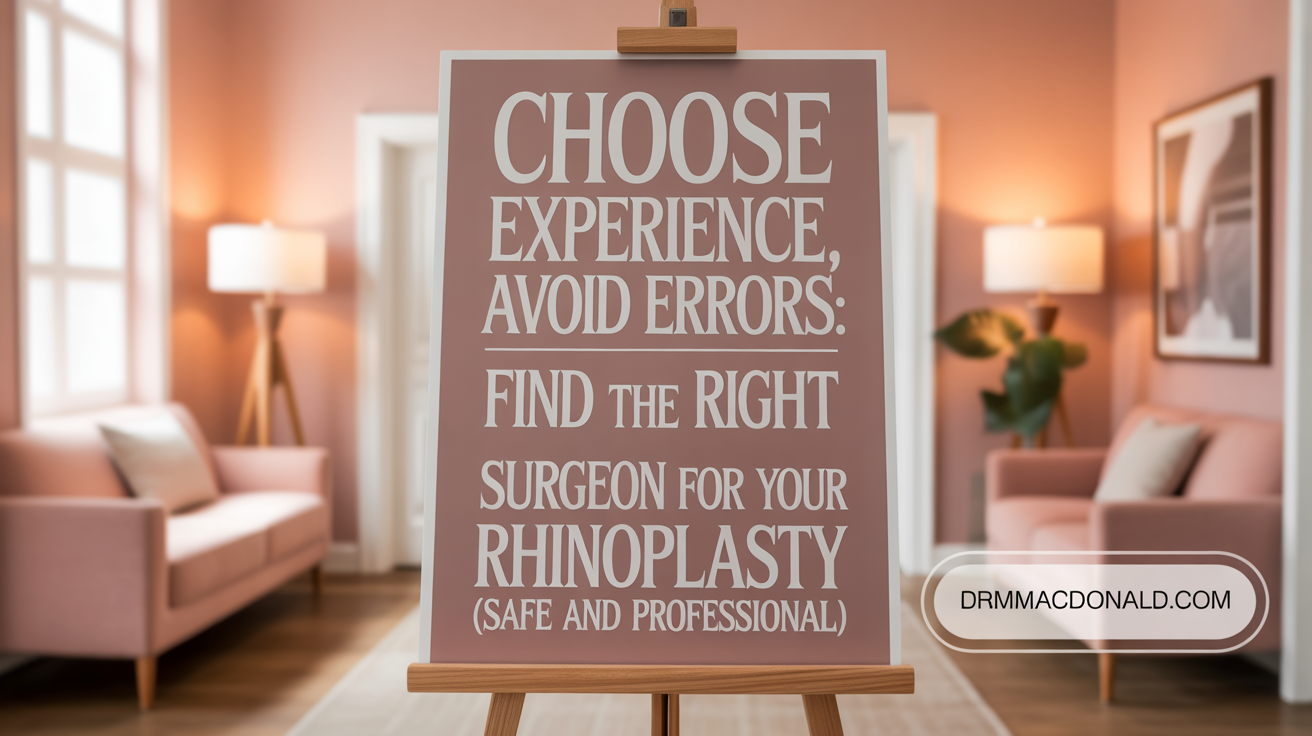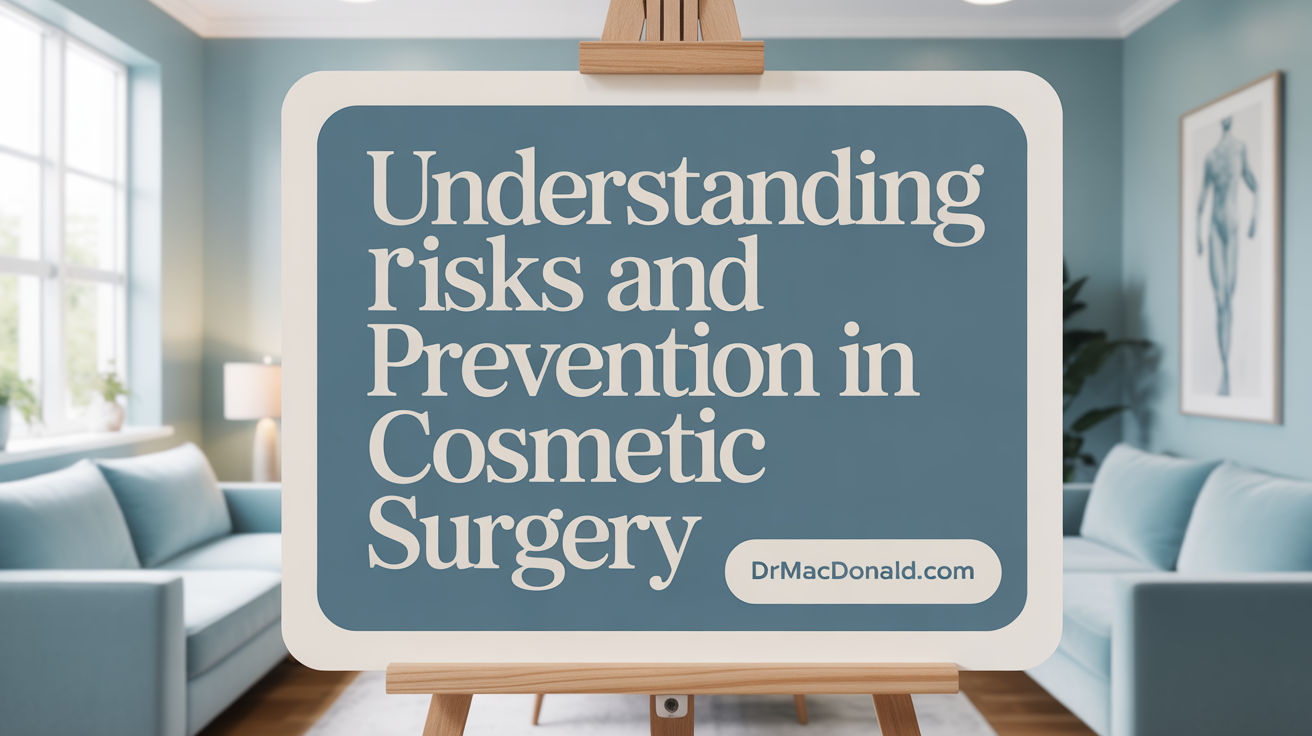Understanding Rhinoplasty and Its Challenges
Rhinoplasty, commonly known as a nose job, is a complex surgical procedure that reshapes the nose to enhance appearance or correct functional issues. Despite being one of the most popular cosmetic surgeries, there are numerous mistakes patients can make that jeopardize their desired outcomes and recovery. This article walks readers through top mistakes to avoid when considering nose surgery, including preparation errors, surgeon selection, post-operative care, and managing risks for safe and satisfying results.
Identifying Suitable Candidates: Who Should Avoid Rhinoplasty?

Who is not a good candidate for rhinoplasty?
Rhinoplasty is a popular procedure to improve nasal appearance or function, but it’s not suitable for everyone. Individuals with serious health conditions, such as heart disease, prior heart attacks, strokes, or uncontrolled chronic illnesses, face higher risks during surgery and recovery. These conditions can complicate healing and increase the chance of adverse outcomes.
Lifestyle factors, especially smoking or use of nicotine products, can severely impair the healing process. It’s recommended to abstain from smoking for at least 12 weeks before and after the procedure to minimize complications like delayed wound healing or infection.
Age is another important consideration. The facial bones and cartilage must be fully developed to ensure stable results. Typically, females should be at least 18 years old, and males should be at least 23, to prevent issues stemming from ongoing facial growth.
Pregnant or breastfeeding women are generally advised to postpone rhinoplasty. The physical stress of surgery and the healing process might pose risks to both mother and baby. Waiting until physical recovery is complete is the safest option.
Individuals with lung conditions such as COPD, pneumonia, or bronchitis should evaluate their health status carefully with their doctor before considering the surgery. These conditions can increase anesthesia risks and impair post-operative recovery.
Mental health also plays a crucial role. Those with body dysmorphia, anxiety, or other psychological concerns should seek counseling before surgery. Unrealistic expectations or psychological distress can impact satisfaction with the results and overall well-being.
In summary, suitable candidates are generally healthy adults who have completed facial growth, do not smoke, and are mentally prepared for the recovery process. Prior medical evaluation and honest communication with a qualified surgeon are essential to determine if rhinoplasty is right for each individual.
Preparation Mistakes: What You Must Know Before Your Nose Job

What are important things to know before getting a nose job?
Preparing for a rhinoplasty involves several critical steps to ensure the best possible outcome. The first step is choosing a surgeon with proven experience and proper certification, such as being certified by the American Board of Plastic Surgery. Reviewing their portfolio of before-and-after photos can offer insight into their aesthetic style and skill level.
Setting realistic expectations is vital. Patients should understand that full recovery and the final shape of the nose can take up to a year or more, as swelling gradually subsides and tissues settle. Swelling often peaks in the first few days post-surgery but can linger in some areas, especially in the nasal tip for longer periods.
Effective communication during the consultation is essential. Patients should clearly articulate their goals, concerns, and any specific features they wish to modify. It’s equally important to discuss individual factors such as skin thickness, nasal structure, and overall facial harmony.
Patients should be cautious about social media influence. Many images online are edited or do not accurately reflect what is achievable for each individual, potentially leading to unrealistic expectations.
Understanding the risks associated with rhinoplasty, including the chance of revision surgeries— which occur in an estimated 7% of cases—is crucial. Potential complications like persistent swelling, asymmetry, or nerve damage should be discussed thoroughly.
Lastly, proper planning for recovery is essential. Taking adequate time off work, avoiding strenuous activities for at least two to three weeks, and following all pre-and post-operative instructions help minimize complications and improve healing.
In summary, a successful nose job depends on meticulous preparation: selecting an experienced surgeon, setting realistic goals, honest communication, and sufficient recovery time. Being well-informed and cautious about social media influences can help you make wise decisions and achieve satisfying results.
Avoiding Technical Errors: The Importance of Surgeon Selection and Surgical Planning

Choosing a surgeon with board certification and experience
Selecting a qualified surgeon is critical for a successful rhinoplasty. Opt for a surgeon certified by the American Board of Plastic Surgery, as this certification indicates rigorous training and expertise. An experienced surgeon understands the intricacies of nasal anatomy and can tailor procedures to meet individual goals, reducing the risk of complications.
Reviewing surgeon’s previous work and patient satisfaction
Before deciding, review before-and-after photos of previous patients to assess the surgeon's aesthetic style and compatibility with your goals. Patient testimonials and satisfaction rates can also provide insights into their skill and professionalism. This diligence helps ensure you choose a practitioner capable of achieving natural-looking, safe results.
Common technical mistakes in rhinoplasty
One of the main causes of revision surgeries is surgical error. Common mistakes include over-reduction of the nasal bridge, which leads to a scooped appearance, and over-aggressive removal of tip cartilage, resulting in deformities like a hanging columella or excessive tip rounding.
Surgical approach selection: open vs closed rhinoplasty
Understanding the difference between open and closed rhinoplasty is essential. Open rhinoplasty involves a small incision across the columella, offering better access for complex reshaping. Closed rhinoplasty is less invasive, with incisions inside the nostrils, usually suitable for minor corrections. The choice influences surgical precision and outcomes.
Preventing deformities and breathing issues through proper technique
Proper surgical technique is fundamental to prevent postoperative deformities such as open roof deformity, crooked noses, or nasal valve collapse. Accurate correction of deviated septa and careful handling of cartilage and bone mitigate breathing problems. Skilled surgeons avoid these pitfalls by employing precise methods tailored to individual anatomy.
| Aspect | Consideration | Impact |
|---|---|---|
| Certification | ABPS certification | Ensures high training standards |
| Experience | Years of practice, specialized skills | Reduces errors and improves results |
| Prior Work | Portfolio and patient reviews | Helps match aesthetic expectations |
| Surgical Method | Open or closed approach | Affects visibility, control, and healing process |
| Technique Precision | Avoiding over-resection and damage | Prevents deformities and breathing issues |
Making an informed decision about your surgeon and understanding the technical aspects of rhinoplasty are vital steps. Proper planning and execution significantly decrease the likelihood of complications and revision surgeries, leading to better, safer, and more satisfying results.
Common Surgical Complications and How to Prevent Them

What are Pollybeak deformity, nasal valve collapse, and over-reduction of the nasal bridge?
Pollybeak deformity occurs when excess tissue or cartilage above the nasal tip creates a bird-like appearance, often from inadequate cartilage reduction or overfilling. Nasal valve collapse happens if the upper lateral cartilages are overly narrowed or not properly repaired, which can impair breathing.
Over-reduction of the nasal bridge happens if the surgeon removes too much bone or cartilage during hump reduction, leading to a scooped or washed-out look.
How do cartilage removal errors affect surgical results?
Removing too much cartilage, especially from the nasal tip, can cause deformities like hanging columella, nostril retraction, or excessive tip rounding. It can weaken the nasal structure, resulting in a less natural appearance.
What causes twisted noses and crooked nasal bones?
These issues often stem from improperly corrected nasal bones or untreated deviations in the septum. A deviated septum can also lead to asymmetry and problems with breathing if not addressed carefully.
What is open roof deformity and how does bone healing influence it?
Open roof deformity occurs when nasal bones aren’t properly closed after hump removal, creating a flattened bridge appearance. Proper repositioning and healing of the bones are essential to restore the natural contour.
What are common causes of breathing difficulties after rhinoplasty?
Breathing issues can result from nasal valve collapse or incorrect repair of nasal structures during surgery. Overly narrowing the nasal passages or improper cartilage support can significantly impair airflow.
How often is revision surgery needed and what causes it?
Approximately 7% of rhinoplasty cases require revision. Common causes include technical errors like over-reduction, asymmetric cartilage removal, or inadequate correction of the septum. Revision procedures are often performed to correct these preventable issues.
| Complication Type | Causes | Prevention Strategies |
|---|---|---|
| Pollybeak deformity | Excess tissue or cartilage overgrowth | Precise cartilage reduction and proper support |
| Nasal valve collapse | Over-narrowing of lateral cartilage | Careful repair and maintenance of airway structures |
| Over-reduction of bridge | Excessive bone/cartilage removal | Conservative tissue removal and proper assessment |
| Twisted or crooked nose | Improper correction of nasal bones or septum | Use of imaging, meticulous surgical techniques |
| Open roof deformity | Failure to close nasal bones properly | Accurate bone repositioning and secure fixation |
| Breathing difficulties | Collapse of airway structures | Reinforcement of nasal valve and septal support |
Post-Operative Mistakes That Can Hinder Your Recovery

Removing nasal splints or packing prematurely
One of the common mistakes post-rhinoplasty is taking out nasal splints or packing too soon. These devices are crucial for maintaining the new shape of the nose and supporting the tissues during healing. Removing them early can cause deformities, bleeding, and compromise the results.
Ignoring surgeon’s post-op instructions
Every patient’s healing process is unique, and following the surgeon’s guidelines is essential. Ignoring advice about activity restrictions, medication use, or care routines can lead to complications like excessive swelling, bleeding, or infection.
Engaging in strenuous or contact activities too early
Patients should avoid vigorous exercise and contact sports for at least three weeks, sometimes longer. Strenuous activities increase blood pressure and can cause bleeding or trauma to the nose, delaying recovery or damaging the surgical outcome.
Wearing glasses or sunglasses that put pressure on the nose
Wearing glasses too soon after surgery can put direct pressure on the healing nasal structures. This pressure can alter the shape or cause fining of the nasal bridge, impacting the final results. It's recommended to avoid glasses for at least four to six weeks or use special frames that do not rest on the nose.
Exposure to sun and skin care during recovery
UV exposure can lead to skin discoloration and swelling, which prolongs healing. Protecting the nose from sun and avoiding harsh skincare products can reduce the risk of pigmentation changes and promote better healing.
Risks of nasal trauma and infection
Accidental bumps or trauma to the nose during recovery can cause bleeding, swelling, or deformities. Also, failing to keep the area clean or neglecting signs of infection can lead to complications, necessitating revision surgeries.
Avoiding nose blowing and sneezing correctly
Nose blowing can put stress on healing tissues and cause bleeding or displacement. Instead, patients are advised to sneeze out of their mouth gently and avoid any vigorous nose blowing to protect the integrity of the surgical results.
| Mistake | Potential Consequences | Prevention Tips |
|---|---|---|
| Removing splints or packing early | Deformities, bleeding, compromised results | Follow surgeon’s instructions on splint removal |
| Ignoring post-op guidelines | Swelling, bleeding, infection | Adhere strictly to prescribed care routines |
| Returning to strenuous activities early | Bleeding, delay in healing, damage to nose | Resume activities gradually after surgeon’s approval |
| Wearing glasses that press on nose | Shape distortion, prolonged swelling | Use glasses with nose support or avoid for weeks |
| Sun exposure and skin neglect | Skin discoloration, delayed healing | Use sunscreen, protect nose from UV rays |
| Trauma or infection | Deformities, prolonged swelling, infection | Be cautious, keep area clean, seek prompt care |
| Improper sneezing techniques | Hemorrhage, displacement of tissues | Sneeze with mouth open, avoid nose blowing |
Choosing the right surgeon and meticulously following post-operative advice are vital to ensure a smooth recovery and optimal results.
Creating a Successful Recovery Plan: Keys to Smooth Healing
Preparing a recovery environment with supplies and assistance
A well-organized recovery space can greatly ease post-surgical healing. Patients should gather essential supplies like cold compresses, gentle cleansers, prescribed creams, and loose, comfortable clothing. Having family or friends available to assist with daily tasks, medication schedules, and emotional support is also beneficial, especially during the first week when swelling and discomfort are at their peak.
Meal planning and hydration
Nutrition plays a vital role in recovery. Preparing nutritious, soft foods can help maintain energy levels while minimizing strain during eating. Staying well-hydrated is equally important, as fluids facilitate healing and reduce swelling. It is advisable to avoid foods high in salt, which can cause additional water retention. Having a planned meal schedule helps ensure consistent nutrient intake.
Managing swelling and bruising
Swelling and bruising are common after rhinoplasty and can be minimized with proper techniques. Keeping the splint on as recommended, avoiding direct ice application but using cold compresses around the nose, and elevating the head at least 45 degrees while resting can significantly reduce swelling. Pain medications prescribed by your surgeon should be taken to manage discomfort effectively.
Avoiding sick contacts and nasal congestion
To prevent nasal congestion and potential complications, patients should avoid contact with anyone suffering from colds or flu. This helps reduce nasal inflammation and congestion, which can hinder healing. Proper hygiene practices, including frequent handwashing, further lower infection risk.
Elevating head and protecting nasal tissues
Proper posture post-surgery aids in drainage and reduces swelling. Patients should keep their heads elevated, especially when sleeping, for the first 1-2 weeks. Protecting the nose from bumping or external pressure is crucial; avoid wearing glasses, engaging in contact sports, or any activity that may put pressure on the nose.
Patience for gradual healing and final results
Complete healing takes time—often up to a year—for swelling to fully subside and the final shape of the nose to settle. Patients should be patient with the process, as subtle changes continue for many months. Following the surgeon’s instructions diligently and avoiding rushing recovery steps are essential for optimal outcomes.
Importance of psychological readiness and mental care
Adjusting to the new nose can be challenging mentally and emotionally. It is important to set realistic expectations through thorough consultation with your surgeon. Practicing relaxation techniques, staying positive, and having a strong support system can help manage psychological stress. Preparing mentally for the recovery period ensures a healthier psychological state and improves the overall experience.
Balancing Risks and Outcomes: How to Ensure Safe, Satisfactory Rhinoplasty
What are the potential risks involved in rhinoplasty?
Rhinoplasty, like any surgical procedure, carries certain risks. Common issues include bleeding, infection, numbness, and scarring. Rare complications such as nasal septal perforation, poor wound healing, or nerve damage can also occur. Swelling and bruising are typical post-op effects but usually diminish within a few weeks. Serious risks are quite rare, occurring in about 1% of cases, but understanding these possibilities helps patients make informed decisions.
Why are realistic expectations and surgeon communication important?
Clear, honest discussions with your surgeon are vital. During consultations, ask about achievable outcomes based on your anatomy and goals. Good communication helps prevent dissatisfaction and sets realistic expectations. Skilled surgeons will review before-and-after photos, explain what results to expect, and discuss potential complications. They will also ask about your medical history to ensure your suitability for the procedure.
How do bargain deals and unaccredited facilities affect safety?
Opting for low-cost or unlicensed surgical centers can increase risks. These facilities may lack proper accreditation, advanced equipment, or emergency support. It’s crucial to choose an accredited facility and experienced, certified surgeons to ensure safe and high-quality care. Avoid surgeons who push additional procedures for extra money without medical necessity, as this can jeopardize your safety.
What role do accreditation and anesthesia play?
Performing rhinoplasty in an accredited surgical center ensures the presence of qualified staff and proper sterilization. The type of anesthesia—local or general—also affects safety and comfort. An experienced anesthesiologist monitors your vital signs closely, reducing anesthesia risks. Always discuss anesthesia options thoroughly with your surgeon beforehand.
How should focus be balanced between cosmetic and functional improvements?
Rhinoplasty often aims to enhance appearance and improve nasal function. Addressing breathing difficulties caused by a deviated septum is as important as reshaping the nose. A skilled surgeon evaluates both aspects during consultation, ensuring the procedure enhances overall facial harmony and nasal health. This comprehensive approach increases satisfaction and reduces the need for revision surgeries.
Why are thorough consultation and second opinions beneficial?
Consultations allow patients to understand potential results, risks, and recovery expectations. Seeking a second opinion can provide reassurance and different perspectives on surgical plans. A well-informed patient who collaborates closely with a qualified surgeon tends to achieve safer and more satisfactory results.
| Aspect | Important Details | Notes |
|---|---|---|
| Risks | Bleeding, infection, numbness, scarring, rare complications | Be aware, not common but possible |
| Surgeon and Facility | Certified, accredited centers, experienced surgeon | Ensures safety and quality |
| Expectations and Communication | Honest dialogue, clear understanding of outcomes | Avoid disappointment and unnecessary revisions |
| Functional vs Cosmetic | Address breathing and appearance | Comprehensive treatment enhances results |
| Informed Decisions | Second opinions, reviewing credentials | Promotes patient confidence and safety |
Taking the time to choose a qualified surgeon, understanding potential risks, and maintaining realistic expectations are essential steps toward a safe, successful rhinoplasty. Proper preparation and ongoing communication help ensure that your journey to a better nose is as smooth and satisfying as possible.
Ensuring Success: Avoid These Mistakes and Embrace Informed Decisions
Avoiding common mistakes when considering nose surgery starts with self-awareness and preparation. Knowing whether you are a good candidate, selecting a qualified and experienced surgeon, and setting realistic expectations are foundational. Equally important is adhering strictly to pre-op and post-op instructions to minimize risks and complications. Patience during recovery, careful planning, and open communication with your medical team ensure you achieve the best possible aesthetic and functional outcomes. By understanding the complexities and committing to informed decision-making, patients can confidently navigate their rhinoplasty journey and enjoy lasting satisfaction with their results.
References
- 3 Common Mistakes People Make While Planning Rhinoplasty
- 10 Things You Should Know Before Getting Nose Surgery
- [PDF] Top 10 Rhinoplasty Mistakes - Profiles Beverly Hills Plastic Surgery
- Common Mistakes in Facial Plastic Surgery
- Rhinoplasty (Nose Job): Surgery, Recovery, Before & After
- Your Top Rhinoplasty Questions Answered | Nose Job FAQs
- How to Avoid Common Mistakes When Selecting Your Plastic Surgeon
- How to Prepare for Your Rhinoplasty: Essential Tips and Guidelines
- Considering a Nose Job? Everything You Need to Know about ...
- Possible Risks Of Rhinoplasty And How To Prevent Them
